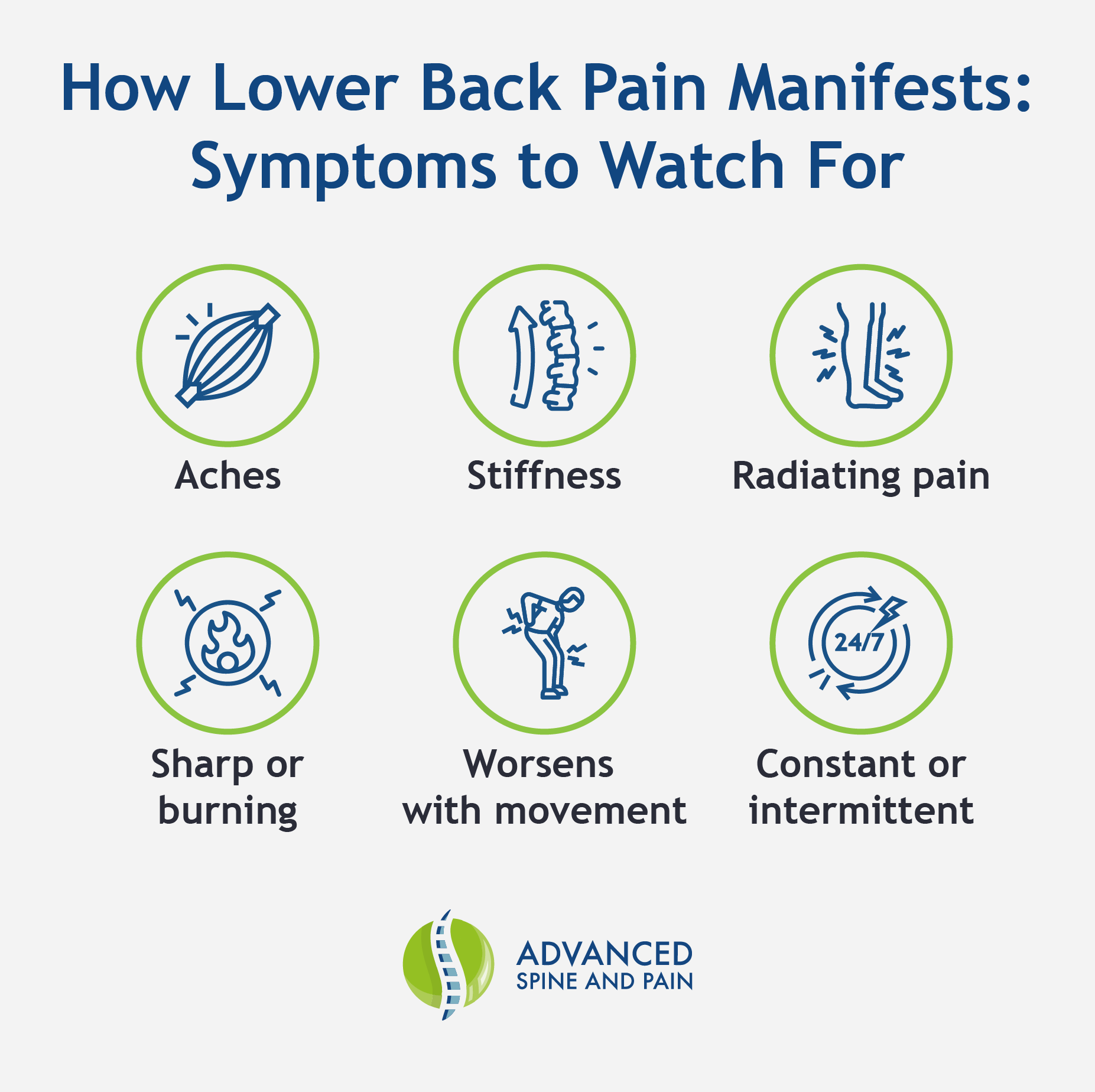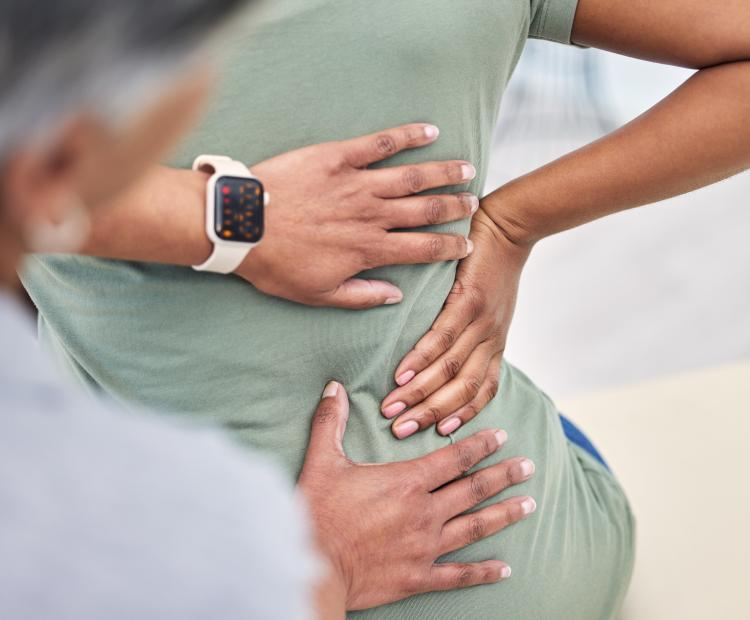Being able to move around easily and perform basic tasks depends on flexible, pain-free movement of your spine. When the lumbar spine, or lower back, is the source of pain, it interferes with movement in ways that can suddenly rob you of independence and quality of life. Treating it effectively is very important for returning to normal activities.
At Advanced Spine and Pain, we specialize in helping people with lower back pain. We offer a variety of treatments and understand how to choose the best solution based on your unique needs and circumstances. If you want to learn more, call today at 480-573-0130
or contact us online.
Understanding Lower Back Pain
Lower back pain is a common condition and causes severe challenges for people who experience it. The World Health Organization (WHO) estimates that 619 million people live with low back pain, making it a leading cause of disability worldwide. 1
Understanding some basic facts about low back pain and what causes it can help when choosing the best treatment option for the condition. Some facts about lower back pain include: 1
- Although low back pain can happen at any age, it is most common between ages 50-55
- It is more common in women than men
- Most people experience it at least once in their lifetime
- Around 90% of cases don’t have a known cause
- Short-term back pain is also called acute back pain
- Long-term pain lasting more than 12 weeks is called chronic lower back pain
Symptoms of Lower Back Pain
Descriptions of lower back pain can vary from a dull ache to more severe pain, such as shooting or stabbing pain, and it can change over time. Bending, reaching, twisting, and sometimes standing and walking can cause discomfort.

Here are some common symptoms of lower back pain:
- Muscle aches
- Stiffness
- Pain that radiates down to the buttocks or legs (sometimes called sciatica)
- A combination of several kinds of pain (dull, sharp, burning, or aching)
- Pain that worsens with movement
- Pain that worsens with rest
- Constant pain (chronic pain)
- Intermittent pain
Each case of low back pain can be different. Acute cases may often improve independently. However, back pain that returns (is recurrent) or is chronic may need additional care.
A few symptoms require immediate medical attention. If you experience numbness, weakness, tingling, loss of bowel or bladder control, or severe worsening pain, contact a healthcare professional immediately.
Causes of Lower Back Pain
Although the cause of lower back pain can’t often be identified, several known causes can be identified by a healthcare provider.1

These include:
- Back injuries such as:
- Fractured vertebrae (the bones in the spine)
- Sprains (overextending ligaments in the spine)
- Strains (injury to the muscles and tendons)
- Changes related to aging, including:
- Degenerative disc disease
- Arthritis
- Osteoporosis
- Structural issues with the lower back:
- Spinal stenosis (narrowing of the spinal canal, causing pressure on the spinal cord)
- Herniated discs (the disc compresses and irritates the local nerves)
- Spondylolisthesis (a vertebra in the spine moves out of alignment)
- Scoliosis (a congenital problem with the spine)
- Inflammation or other conditions
- Inflammatory arthritis, such as ankylosing spondylitis
- Fibromyalgia (a condition causing muscle pain)
- Health problems unrelated to the spine, such as kidney stones, endometriosis, cancer, and others
Risk Factors for Low Back Pain
Although you can’t control factors like aging or gender, a few risk factors can be decreased with lifestyle changes. These include smoking, obesity, physically demanding work, and low physical activity. 1 Staying fit, practicing safe lifting at work, maintaining a healthy weight, and eliminating habits like smoking can help reduce your risk.
How to Relieve Lower Back Pain
Treatment for lower back pain varies depending on the cause and source of the pain. Your healthcare provider may perform several tests to pinpoint the cause of your back pain, including X-rays, CT scans, MRI, myelogram, medial branch blocks, electrodiagnostic testing, and discography.
After testing, reviewing medical history, and a physical examination, recommendations can be made tailored to the back pain's findings and any likely causes (or, if none is found, the location of the source of the pain).
Many approaches can be taken to fix lower back pain, and sometimes more than one is used at the same time:
Medication
Medication can help reduce pain until an injury heals so that other treatments, like physical therapy, are easier to perform. Options include:
- Over-the-counter pain medication
- Muscle relaxants
- Opioid pain medication
- Corticosteroids
- Pain-relieving ointments
- Lidocaine patches
- Certain antidepressants
- Anticonvulsants
Non-invasive treatment
Along with medication, specific measures can help relieve lower back pain without requiring a procedure. These may include self-care steps taken at home to ease discomfort:
- Restrict heavy lifting or strenuous activity until directed by your doctor
- Use of cold or hot packs or a heating pad for back pain relief
- Physical therapy to strengthen muscles and stabilize support of the spine
- Acupuncture
- Transcutaneous electrical nerve stimulation (TENS)
- Bracing to provide additional support during recovery
Minimally invasive and surgical procedures
There are longer-term options for pain relief. Advanced Spine and Pain has board-certified pain specialists who offer many of these treatment options, including:
- Minimally invasive lumbar decompression (MILD)— a procedure that helps alleviate lower back pain due to lumbar spinal stenosis
- Laser-assisted neural decompression (LAND)— a less invasive alternative to traditional minimally-invasive spine surgery
- Lateral interspinous fusion therapy (LIFT)— a less-invasive alternative to traditional fusion procedures that stabilizes the spin without screws and rods
- SIT procedure— treats lower back pain that originates from the SI joint
- DISC procedure— an alternative to surgery that helps address disc breakdown in degenerative disc disease
- Manipulation under anesthesia (MUA)— helps to break up scar tissue that has formed in the muscles, near the joint capsule, or around the nerve root
- Kyphoplasty— a surgical procedure used to stabilize fractured vertebrae (spinal bones), a condition that often results from osteoporosis
- Radiofrequency ablation— a procedure that targets nerve endings causing pain, preventing pain signals from being transmitted
- Epidural steroid injections— used to reduce inflammation and pain directly at the spinal column
- Facet joint injections— to relieve inflammation and nerve pain originating from lumbar facet joints
These options can restore normal activity levels and independence. They may also be a part of a larger strategy and combined with medication and non-invasive options like physical therapy to ensure the best possible outcome and relieve pain.
Not Sure What To Do Next for Lower Back Pain?
Navigating the many causes of lower back pain and treatment options can feel overwhelming. With support from Advanced Spine and Pain specialists, you can gain the confidence needed to make the best choice for managing your lower back pain. We’re ready to review your personalized plan today and help eliminate chronic pain—contact us online or call us at 480-573-0130
.
References
-
World Health Organization. (2023, June 19).
Low back pain. World Health Organization.
https://www.who.int/news-room/fact-sheets/detail/low-back-pain
-
National Institute of Arthritis and Musculoskeletal and Skin Diseases.
“Back Pain.” National Institute of Arthritis and Musculoskeletal and Skin Diseases,
23 Apr.
- Log in to post comments

